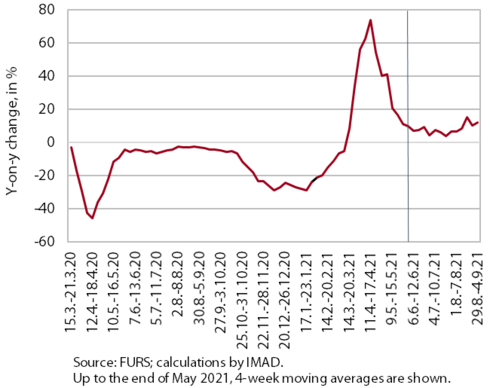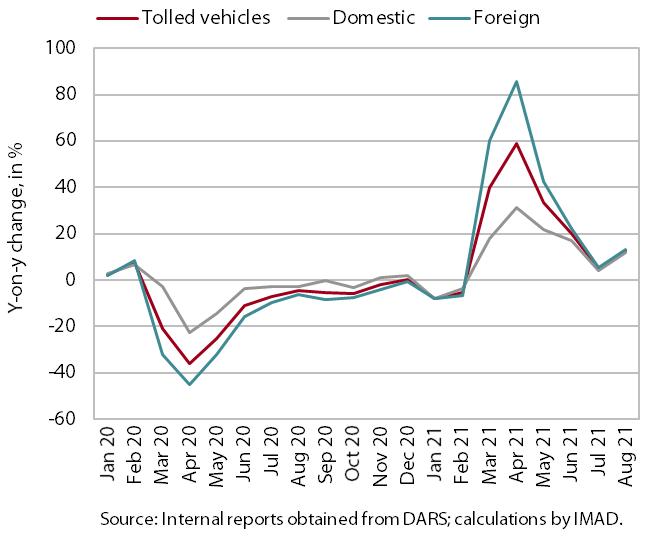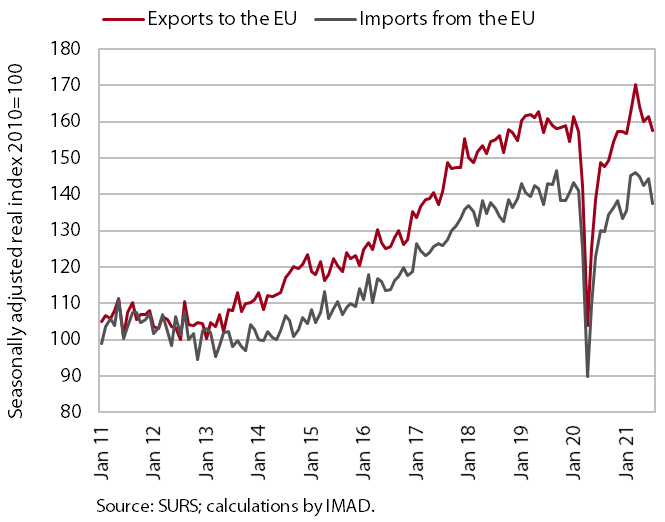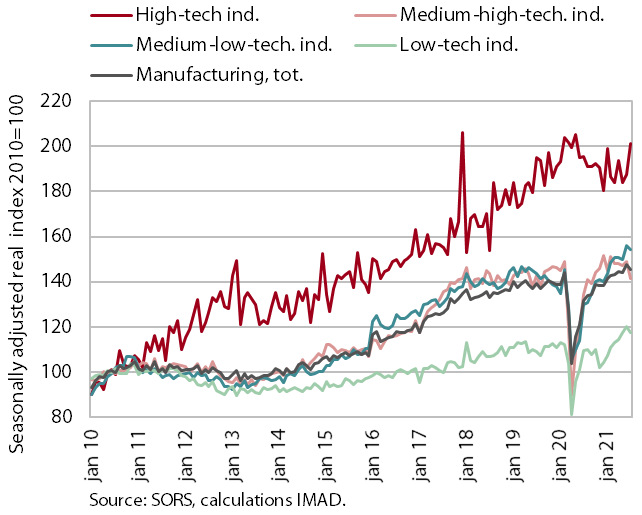Charts of the Week
Current economic trends from 6 to 10 September 2021: fiscal verification of invoices, traffic of electronically tolled vehicles, trade in goods and other charts
At the end of August, the favourable trend in trade and tourism-related activities continued, as shown by data on the fiscal verification of invoices. Total turnover was higher than in the same period of 2019, but still lagged far behind the pre-epidemic period in some activities. In August, traffic of electronically tolled vehicles on Slovenian motorways was also higher than in the same period before the epidemic. The latest available data show that activity in the export-oriented part of the economy fell slightly in July, mainly due to disruptions in the supply of raw materials in the automotive industry.
Fiscal verification of invoices, August–September 2021

According to data on the fiscal verification of invoices, total turnover between 22 August and 4 September was 11% higher year-on-year and 7% higher than in the same period of 2019. Positive trends in trade continued, with sales 10% higher year-on-year and 7% higher than in 2019. Even higher year-on-year turnover growth (due to a low base) was recorded in travel agency activities, accommodation, food and beverage service activities and sports activities. Turnover growth was driven by a larger number of foreign tourists as well as the redemption of vouchers introduced last year and this year. Turnover in certain services (accommodation and food service activities, sports activities) was also higher than in the same period of 2019, while turnover in other services (travel agency activities and casinos) was lower (by about a half and a fifth, respectively).
Traffic of electronically tolled vehicles on Slovenian motorways, August 2021

Freight traffic on Slovenian motorways in August was up 13% year-on-year and up 7% compared with August 2019. The year-on-year recovery (and also compared to the same two months in 2019) can be attributed to one less working day in July and one more in August this year. After adjusting the data for working days, the volume of freight traffic was 3% higher than in August 2019.
Trade in goods, July 2021

Trade in goods fell again in July, but remained higher than last year. In recent months, growth in exports of goods to EU Member States came to a halt, which we believe is related to lower exports of vehicles. The shortage of electronic built-in components has severely paralysed the production of vehicles and, consequently, their exports, which accounts for about one-sixth of total exports of goods. Among the main product groups, the positive trend in exports of metals and machinery and electrical equipment continues and remains well above pre-epidemic levels. The decline in imports is related to somewhat lower manufacturing activity in Slovenia. In August, export expectations improved. Despite the disruptions in the supply of raw materials and longer delivery times (PMI), which have the greatest impact on the automotive industry, firms remain more optimistic about future foreign demand than before the epidemic.
Production volume in manufacturing, July 2021

Production volume in manufacturing fell in July compared to the previous month, but was still higher than in the same month last year and in 2019. This was largely due to reduced activity in medium-high technology industries, mainly due to supply disruptions in the automotive industry. A decline was recorded also in medium-low and low technology industries, while high-technology industries recorded relatively high growth. Total manufacturing production continued to exceed the level of the same period last year. The lowest year-on-year growth was recorded in medium-high technology industries, mainly due to unfavourable developments in the automotive industry. This is also the main reason why the production of medium-high technology activities is lagging behind the level of the same period in 2019. Production in some other industries, such as the production of metals, electrical equipment, food and non-metallic mineral products, was also lower than in July 2019.
